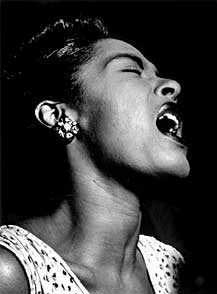Lady Day

"Her melody is rich with dissonance, and when Billie sings, ‘My man don’t love me’ on those dissonant notes, she can chill the blood. This ability to tell us something real made her not merely the finest of all jazz singers, but one of the finest jazz musicians American has produced." -- J.L. Collier.
Indisputably one of the great singers of the 20th century (Frank Sinatra called her "the most important influence on popular singing" of her time), Holiday’s voice was raw and round and tiny -- like that of a husky alley kitten -- but in every line she sang, she invited her listeners into her sometimes horrifying inner world, with its genuine appetites, pain and fleeting hopes. She said she was aiming at capturing the big sound of Bessie Smith, with the feeling of Louis Armstrong’s behind-the-beat cornet playing; but in addition, she had uncanny instincts about dramatic balance, knowing when to minimize the form to make the sometimes outlandishly overwrought content of the songs which were written for her seem simple, elegant and authentic.
Born Eleanora Fagan on this day in 1915 in Baltimore, Holiday’s early life is mysterious, obscured by the fanciful cocktail served up in her ghost-written autobiography, Lady Sings the Blues (1956), but it is surmised that she lived with relatives in Maryland while her mother went to New York to look for work; that her natural father, Clarence Holiday, was a guitarist in Fletcher Henderson’s band; and that Billie came to New York in 1927, worked in a brothel, and spent a little time in jail.
Legend has it that her singing career started when she was 15: as she and her mother were about to be evicted from their apartment for not paying their rent, Billie pushed her way into a dancing audition at a New York club, Pod and Jerry’s. A moment into the audition, it became very clear that Billie was no dancer, but the pianist took pity on her and asked her if she could sing. She tried "Trav’lin’ All Alone" and "Body and Soul," after which the customers sat in stunned silence, some of them moved to tears, and the owner sent her home with a couple of chickens and enough money to pay the rent.
By 1933, she was a regular in clubs around 133rd Street, when talent scout John Hammond arranged to have her record a few sides with Benny Goodman. Later with small bands led by Teddy Wilson, featuring such giants as Lester Young, Ben Webster, Roy Eldridge and Johnny Hodges, Holiday recorded some of the quintessential classics of jazz, including "These Foolish Things," "I’ll Get By" and "Gettin’ Some Fun Out of Life." In 1937, she sang with the Count Basie Band, but did not mix well with Basie personally; and joined Artie Shaw in 1938 as Shaw boldly attempted to break the color line.
The strain of race relations while on the road led her to split with Shaw, after which she landed a steady headlining gig at Barney Josephson’s Cafe Society in Greenwich Village, an early attempt to mix upscale black and white audiences and present top-flight black and white entertainment. The engagement took Holiday from being an admired singer within the narrow circle of jazz musicians and enthusiasts to a national crooning phenomenon. Pressed by popular tastes, she pulled away from classic bluesy and light jazz-pop to sing torch songs -- slow tempo tales of love gone awry. In addition to "Strange Fruit" (an anti-lynching song which became her anthem, sending chills down the spines of Cafe Society patrons in 1939), "Fine and Mellow" and "God Bless the Child," she had hits with "Lover Man," "Good Morning Heartache" and "Gloomy Sunday."
Beginning in 1942, however, Holiday had a string of four failed marriages to drug addicts, and in the course of being physically and mentally abused by these men (who preyed on her leviathan lack of self-esteem), she became a heroin addict herself, and spent most of 1947 in prison following a drug arrest. While this resulted in her cabaret card being revoked (New York City law prohibited felons from working in places where alcohol was served), she made a triumphant return to Carnegie Hall in 1948. In 1949, she was arrested in a narcotics frame-up on the West coast (third husband John Levy was the likely stoolie), but released on testimony that she was clean at the time. Years of alcohol (to which she turned when attempting to stay clear of heroin), fitful drug use and temperamental behavior were making her persona non grata at clubs, and were taking their toll on her health and voice by the early 1950s.
At the age of 43 she was sounding 70, croaking her way through recordings for Verve which nonetheless still captured her bold interpretative touch. She was still moving live audiences, perhaps displaying her real-life torments so close to the surface that one could not help but be moved by the reality behind the artifice, when in 1959 she collapsed from liver trouble, went into a coma for a time, rallied but was set back by a kidney infection. As a final insult, although she was probably clean, she was arrested yet again for drug possession and fingerprinted on her deathbed at the age of 46. She passed away on July 17, 1959 in New York City.
Labels: Classic Pop Music, Jazz





1 Comments:
Great stuff! How bout that John Hammond? In addition to discovering and signing Lady Day, he also nabbed Count Basie, Pete Seeger, Dylan, Springsteen, Benny Goodman, Aretha, Robert Johnson, etc.
We need more like him now, and less American Idol garbage.
Post a Comment
Subscribe to Post Comments [Atom]
<< Home